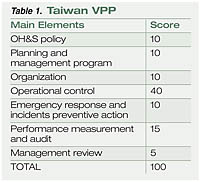Taiwan, like other developing countries, is finding success in applying an integrated approach to occupational safety and health management. Patterned after OSHA’s program, the Taiwan VPP dates back to 1994. In 2001 it was updated to include characteristics of international occupational health and safety management systems (such as OHSAS 18001). The main elements and audit scores for the Taiwan VPP are shown in Table 1.
Worksites in Taiwan can achieve VPP Star by obtaining a score of 85 percent or higher. VPP Merit is achieved with a score over 70 percent. Incentives include a waived general regulatory inspection and insurance premium reductions. By the end of 2003, 724 worksites in Taiwan were granted VPP awards.

Value of integration
An integrated approach to safety and health is today’s best management practice and is demonstrated where employers combine segregated programs, including those that have a peripheral influence on worker health and safety, into a managed system.Studies have shown that integrating health and safety programs into a cohesive system improves results. What happens if we integrate a worker health and safety system such as VPP with a worksite health promotion program/system?
A review of white papers relating to NIOSH’s Steps to a Healthier U.S. Workforce — http://www.cdc.gov/niosh/steps/default.html — finds both systems improve. When systems designed to prevent work injuries and illness and promote healthy living are integrated, worker smoking cessation rates are doubled when compared to a traditional health promotion-only program. And workplace injury and illness rates decline, too.
A 2005 report, Integrating Employee Health: A Model Program for NASA, published by the U.S. Institute of Medicine, reinforces the value of integration and recommends that NASA follow this path.

A case for change
The IOM’s model program for NASA identifies current focal points of typical workplace safety and health programs, and suggests more “desired states.†These current trends and desired states are shown in Table 2. The IOM emphasizes an important paradigm shift: promote positive outcomes over negative ones.Business imperative
Ron Goetzel, director of the Institute for Health and Productivity Studies at Cornell University, reports in a January 2005 NIOSH “Steps†white paper: “Integrated health, safety and productivity management programs are emerging as a business imperative aimed at improving the total value of human resource investments.â€However, before integration is achieved, a number of barriers must be overcome. These include turf protection, manager complaints of lack of time and limited resources, departments operating under different rules, arguments for status quo, and lack of convincing evidence that integrated systems are truly effective.
Proof is mounting that integrating loosely coupled or completely disconnected programs into systems can improve worker health and safety, both on and off the job. But you do have to dig to find it. Research best management practices and the performance benefits that can come from rebuilding program “silos†into a comprehensive system. To overcome organizational barriers and outright inertia, be prepared to make the business case for changing the traditional focus and structure of safety and health programs.


